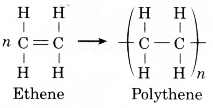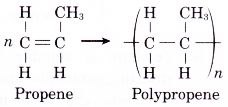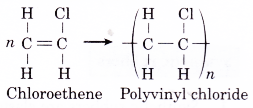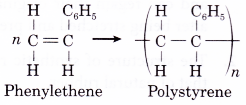What is the most common type of plastic?
Plastics:
- Plastics are made from the products of cracking of petroleum fractions such as alkenes molecules through addition polymerisation.
- Plastics are the largest group of synthetic polymers with the following properties:
- Can be easily moulded and coloured
- Low density
- Strong
- Inert to chemicals
- Insulator of heat and electricity
- Impermeable
- Non-biodegradable
- Table shows some examples of commonly used plastics, how they are formed, their properties and uses.
| Name of polymer | Equation for polymerisation | Properties | Uses |
Polyethylene |  | Durable, light, impermeable, inert to chemicals, easily melted, insulator | Shopping bags, plastic cups and plates, toys |
| Polypropylene (polypropene) |  | Durable, light, impermeable, inert to chemicals, easily melted, insulator, can be moulded and coloured | Bottles, furniture, battery casing, pipes, toys |
| Polyvinyl chloride (polychloroethene) |  | Low softening temperature, durable, elastic, can be coloured | Pipes, pipe fittings, wire and cable casing, raincoats, footwear, bags |
| Polystyrene |  | Heat insulator, light, can be moulded, impermeable | Disposable cups and plates, packaging materials, toys, heat insulators. |
| Perspex |  | Transparent, strong, light | Replacement for glass, lenses and optical fibres |
| Teflon |  | Durable, non-stick, chemically inert, strong, impermeable | Coatings for non-stick pans, electrical insulators |
People also ask
- What are Synthetic Fibres and give some Examples
- What are the Advantages and Disadvantages of Synthetic Fibres
- Is Polyester Synthetic or Artificial
- How polymers are classified?
- Justify the uses of synthetic polymers in daily life
Synthetic rubbers
- Synthetic rubbers are elastomers that are elastic and can regain their original length and shape after being stretched and pressed.
- The structure of synthetic rubbers is similar to that of natural rubber.
- Synthetic rubbers are produced by addition polymerisation.
- Neoprene and styrene-butadiene rubber (SBR) are examples of synthetic rubber.
- Neoprene is elastic and resistant to oil and is suitable to make rubber host and toys.
- Styrene-butadiene rubber, SBR rubber is very suitable for making car tires and shoes because it is elastic and hard.
